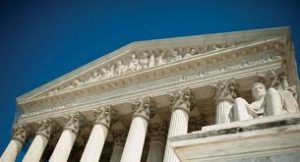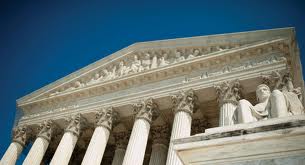The U.S. Supreme Court has granted certiorari in NLRB v. Noel Canning[ref]705 F.3d 490 (D.C. Cir. 2013)[/ref], a case from the U.S. Court of Appeals of the District of Columbia which held that President Obama’s recess appointment of three members to the National Labor Relations Board was unconstitutional. The decision found that a president could not exercise his power to make recess  appointments during a period when the Senate was not between sessions of Congress.
appointments during a period when the Senate was not between sessions of Congress.
The Court’s decision to hear Noel Canning has direct implications for Richard Cordray, Director of the Consumer Financial Protection Bureau, who was appointed on the same day as the three NLRB commissioners whose appointments were declared unconstitutional. The Court’s order granting certiorari directs the parties to brief and argue one question: “Whether the President’s recess-appointment power may be exercised when the Senate is convening every three days in pro forma sessions.”
The Constitution provides that the President may appoint Offices of the United States, like Director Cordray and the three NLRB commissioners, “With the Advice and Consent of the Senate.”[ref]Constitution, Article II, Section 2, Clause 2[/ref]. Neither Director Cordrary nor the three NLRB appointments were made made “With the Advice and Consent of the Senate.” All four appointments were made by the President utilizing his Constitutional power to make appointments to fill vacancies “during the Recess of the Senate.”[ref]Constitution, Article II, Section 2, Clause 3[/ref] It all comes down to whether the Senate was in session on Jan. 4, 2012, when the President made all these recess appointments.
On Dec. 17, 2011, the Senate passed a unanimous consent agreement providing that the Senate would meet in pro forma sessions every three business days from Dec. 20, 2011, to Jan. 23, 2012.[ref]157 Cong. Rec. S8,783–84 (dailyed. Dec. 17, 2011)[/ref] The Constitution provides that neither body of Congress may adjourn for more than three days without consent of the other. [ref]Constitution, Article I, Section 5, Clause 4[/ref] By agreeing to meet every three business days, the Senate avoids a recess and remains in session, even though those sessions may be for just a few minutes.[ref]A pro forma session of the Senate is described by the Senate’s website as “a brief meeting of the Senate (sometimes only a few minutes in duration).”[/ref]
The argument in Noel Canning focused on the “during the Recess of the Senate” language contained in the President’s recess appointment power. The NLRB argued this means any recess of the Senate, like an adjournment, triggers the President’s recess appointment power. The Noel Canning company argued that the power only arises when the Senate is in “the Recess,” which it described as the period when the Senate is between sessions — that is, when one session of Congress has ended and the other has not yet convened.
The U.S. Court of Appeals agreed with Noel Canning, finding that the NLRB’s interpretation could be construed to allow a president to make recess appointments even during short adjournments. Under this interpretation, even if the Senate has not convened during a three-day period, within an ongoing session, it is not in “the Recess” period between two sessions of Congress, which according to the decision, is the only time a president can exercise the recess appointment power.
And this is where the timing of Director Cordray’s appointment is critical.
On Jan. 3, 2012, during a pro forma session, the Senate convened the second session of the 112th Congress, which it is required to do every Jan. 3rd.[ref]158 Cong. Rec. S1 (daily ed. Jan. 3, 2012); see U.S. Const. amend. XX, § 2[/ref]. President Obama appointed the three NLRB commissioners and Richard Cordray as Director of the CFPB on Jan. 4, 2012, the first day following the start of the second session of the 112th Congress.
Had the appointments been made between the time the Senate went into pro forma sessions on Dec. 20, 2011, and before the Jan. 3, 2012, start of the 111th Congress, the Noel Canning decision might have turned out different. The timing here couldn’t be worse for this test of the breadth of the Executive’s recess appointment power, because it occurred during a session of Congress. Although other presidents have made recess appointments during sessions of Congress (as opposed to between sessions), this historical fact had little sway on the Court of Appeals’ decision.
The Supreme Court, having framed the question as it did, will consider whether a president has the power to make a recess appointment when the Senate is not in “the Recess,” but is rather simply meeting, albeit pro forma, during a session of Congress.
The implications for the CFPB are extraordinary if the Court affirms the decision below. If the CFPB did not have a validly appointed Director, all of its rule making, enforcement actions and other activities requiring the approval of a director may very well be invalid.


